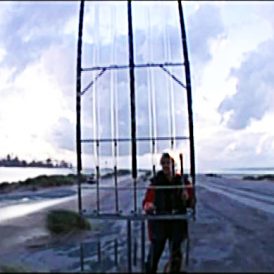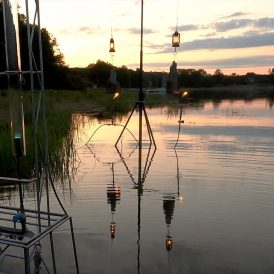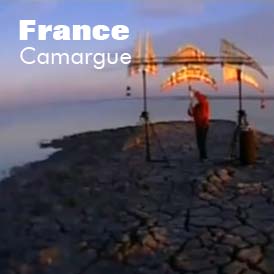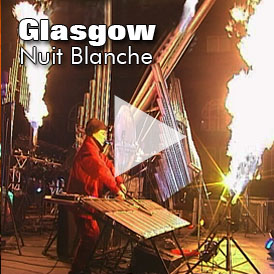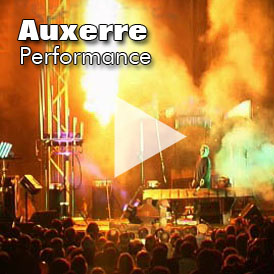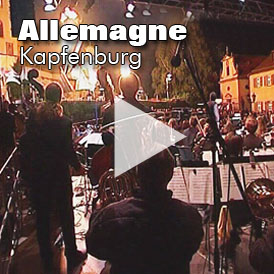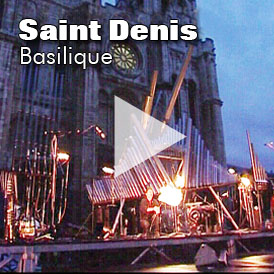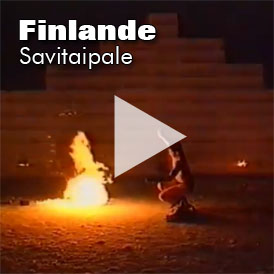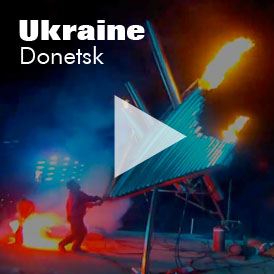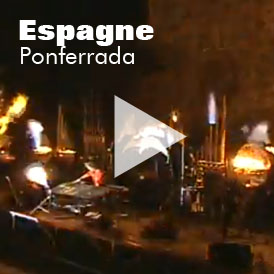MICHEL MOGLIA
The Spirit of Fire
« With Michel Moglia’s sound sculptures begins a story of breathing and fire, of sirens and dragons, of light and song. For over ten years, his Fire Organs have been lighting up the night sky in the cities of France and those of other countries, spitting their otherworldly tones skyward.
Before discovering the sound potential of fire, Michel Moglia began his career studying the classical flute for fifteen years and then learning to play the peul flute from the Sahara. He was also profoundly marked by his discovery of the ritual dances of possession during his two years’ national service in Niger .These various influences rapidly led him to question the concepts of beauty and harmony inherent in the musical world of contemporary Western civilisation. “One day I decided to make my own vibration within our planet’s luxuriant world of sound. And so I created my song, in the end identical to that of a wolf, but using human means, especially the fire that burns within us and governs our breathing. For me, fire is fascinating because it is Good and Evil at the same time. As Gaston Bachelard puts it so well in La Psychanalyse du Feu “The Psychoanalysis of Fire”:
“Fire shines in Paradise and burns in Hell”.
In 1989, this passion for pyrotechnics was to give birth to the Fire Organ, based on a process in which the heat of a flame was converted into sound energy. In fact, the instrument did not have a name at first. It was so named by its first audiences. In practical terms, it is operated by a series of burners fuelled by liquid gas, which shoot flames into steel tubes fixed on a metallic structure. The hot air’s circulation in the tubes produces tones that are eerily reminiscent of the cries of certain creatures, real or mythical, such as the wolf’s howl, the siren’s son or the dragon’s roar.
The past has seen other musical instruments harnessing the energy of fire. Hence, the Pyrophone or “singing flames”, an improved version of an earlier instrument called the Chemical Harmonica, was made by Frédéric Kastner in the mid-nineteenth century. This also worked on the same principle. Flames caused columns of air contained in glass tubes to vibrate. In more recent times, two Danish musicians, Bastiaan Maris and Geo Homsy, invented the Large Hot Pipe Organ in 1992, an organ powered by propane and controlled remotely via an MIDI computer system. More recently also, Jacques Rémus, a leading figure in modern mechanical music, has worked on the invention of Thermophones, no longer powered by gas but using energy produced by very low temperatures. Apart from these few prototypes, musicians can be found here and there who have carried out various experiments based on analogue processes.
For its inventor, the Fire Organ is more than just a sculpture, it is first and foremost a marvellous interface between the universe of sound and the living world. “I feel absolutely no affinity with lutherie, thermal or otherwise. Hence, I am in no way an “organ builder”. I do not consider my sculptures as belonging to the music world, as their purpose is not to interact with other “musical” instruments manipulated by humans. I would like them in part to fill this sort of missing link between the fascinating vibrations of the world of sound arising directly from nature – birdsong, the songs of wolves and whales, for example – and human expressions of sound.”
In this quest, nothing is left to chance, even if the end result always contains an empirical element, inseparable from the element of fire itself. In light of the risks involved, safety restrictions have been raised as far as possible, well beyond regulatory standards. The external appearance of the Fire Organ has been closely dictated by all the technical constraints involved in its construction. “It can be likened to a sailboat designed without the slightest concession. It is vital for me that the artistic aspect not be “contrived” for the sake of aesthetics, or in other words be artificial. Moreover, I am just as wary of my own tastes (in part a product of my upbringing in a certain world at a certain time) as of those of the current artistic world.”
In 1990, a giant Fire Organ, manufactured with pipeline tubes, saw the light of day outside the Dobryanka power station, close to the Urals city of Perm. Finalised with the aid of the Centre national des Arts Plastiques (French National Centre for Visual Arts), this exceptional performance both on a human and technical level, was staged, at the request of Soviet energy officials, in order to harness the power station’s fire and convert it into a range of sounds. And so the first Thermal Chant was born, a mammoth staging concept, one of a kind, blending sound art and visual art in the same melting pot. The shows were always held at night or in an enclosed place away from daylight. The Fire Organ was shown to advantage as it unfurled its nine-metre height over a facade of twenty metres. Composed of five separate metallic structures, supporting around 200 tubes in stainless steel, titanium and glass of different lengths and diameters, it was a real “beast” belching flames and sounds, and producing mysterious vibrations to fire the most sterile of imaginations.
On Reunion Island, another instrument in stainless steel was built with the active involvement of artists, musicians and dancers of the local scene. Built in 1999 to celebrate the millennium of the city of Saint Pierre, it was constructed entirely on site. Yet another, designed for the opening of the Festival of Scenic Art, is located in Sao Paulo in Brazil, where it has become the property of the Social Service of the National Federation of Commerce.
Apart from the Fire Organ, the expandable, informal family used in the “Thermal Chants” also includes thermal, manual or automatic pendulums, continuos, flutes and blasts of air. »
An excerpt from the book LES CHERCHEURS DE SON (a book presenting 30 inventors of musical instruments) by Gérard Nicollet and Vincent Bruno (Editions Alternatives)
C.V.
Literary studies (Paris IV Sorbonne).
Flute studies under the direction of Robert Hériché of the Opéra de Paris.
Professor of French Languages and Literature.
Stay in Niger during national service.
Discovery and study of the ritual of dances of possession in Niger.
Initiation by Peul nomads in playing the vertical flute.
Photographic reporter (West Africa, Sahara).
Sailing and scuba diving instructor.
1987 First public creative work: ceramic firing under sail, on the open sea.
1988 Purchase by the Fond National d’Art Contemporain (National Fund of Contemporary Art), Paris: Bouclier durci par la flamme (Shield hardened by fire).
1989 Grant from the Délégation aux Arts Plastiques (French visual arts delegation). Creation of the first Fire Organ.
Water, Earth, Fire, Metal… and Sound.
Michel Moglia uses fire as an inspirational element for his creative works, in conjunction with water, earth and metal. The analogy between vibrations linked to the phenomena of combustion on the one hand, and the mechanism of breathing on the other hand, prompted him to create the first Fire Organ in 1989 in order to convert thermal energy directly into sound energy.
In 1990, with the help of a grant awarded by the Centre National des Arts plastiques (National Centre for Visual Arts),he accepted an invitation to stage an exceptional performance at the power station in Perm in the former USSR. With his gigantic fire organ, created from pipeline tubes, he harnessed the station’s energy to produce a thermal chant before an audience of ten thousand.
Since then, he has divided his time between research, creation and performance for specific public exhibitions and events, such as in Belo-Horizonte, Sao-Paulo, Istanbul, at the Baalbeck International Festival in the Lebanon, in front of the Géode at the Cité des Sciences science and technology centre and at the Cité de la Musique cultural centre, both located in Paris, in front of the Coliseum for the White Night in Rome and lastly in Reykjavik in association with Icelandic musicians for the “French springtime in Iceland” festival …
TECHNICAL ADVISOR: Pierre JOULAIN
Member of NFPA SFPE: National Fire Protection Agency. Society of Fire Protection Engineers
Visiting professor of the Fire Protection Engineering Department University of Maryland,
College Park. Research Director at the Centre National de la Recherche Scientifique (National Centre for Scientific Research) Laboratoire de Combustion et de détonique de Poitiers (Poitiers Laboratory of Combustion and Detonics). Member of the International Association of Fire Safety Service (IAFSS). In July 1999 in France, host to the Sixth International Symposium of IAFSS.

